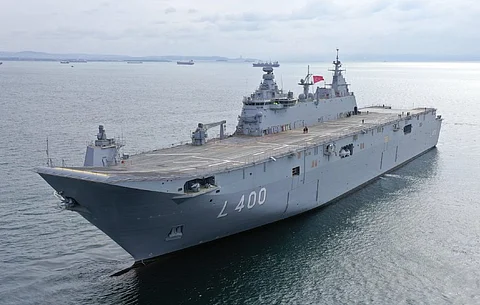

A new landing helicopter dock (LHD) that can also be configured to accommodate tactical jet aircraft was recently handed over to the Turkish Navy.
The future TCG Anadolu was built locally by Sedef Shipyard to a design by Spanish naval shipbuilder Navantia. The ship is named after Turkey's Anatolia peninsula, on which the majority of the country's land mass is found.
Currently the Turkish Navy's largest ship as well as the service's flagship, the LHD has a length of 232 metres, a beam of 32 metres, a draught of 6.8 metres, a displacement of over 27,400 tonnes, and capacity for troops and various vehicles including unmanned aerial vehicles (UAVs). The crew complement will include 30 officers and 231 enlisted sailors. Anadolu's base design is nearly identical to that of Juan Carlos I, an amphibious assault ship/aircraft carrier built by Navantia for the Spanish Navy.
In addition to the UAVs, Anadolu's air wing will initially consist of helicopters including those used for ground attack, utility/transport, and anti-submarine warfare. A maximum of 14 helicopters can be embarked at any given time. The ship can also be configured to operate F-35B Lightning II multi-role combat aircraft with short take-off/vertical landing (STOVL) capability should the Turkish government decide to proceed with their purchase in the future.
The well deck can meanwhile house either four landing craft mechanised (LCM) or two larger landing craft air-cushion (LCAC). Garage space totalling 1,410 square metres is available for various land vehicles such as main battle tanks and amphibious assault vehicles. The garage space may also be used for the transport of containerised cargo when the ship is deployed for supporting humanitarian and disaster response missions.
The ship is powered by five MAN diesel generators that each produce 8,000 kW to drive two Siemens 11MW azimuthing podded thrusters, delivering a maximum speed of 21 knots and a range of 9,000 nautical miles at a cruising speed of 16 knots. For added manoeuvrability in close quarters, two 1,500kW bow thrusters are fitted.
Although the air wing comprises the LHD's main offensive and defensive firepower, the ship still has limited self-defence capability against small airborne and seaborne threats such as small boats and drones. The LHD's defensive armament consists of a Phalanx 20mm close-in weapon system, five 25mm autocannon mounted on Aselsan remote weapon stations, and RIM-116 surface-to-air missiles. An Aselsan/Havelsan combat management system is linked to the LHD's Thales air and surface, search and tracking radar and Armelsan diver detection sonar. A separate Leonardo SPN-720 radar will assist in aircraft landings performed under adverse weather conditions.
| TCG Anadolu | |
| SPECIFICATIONS | |
| Type of vessel: | Landing helicopter dock |
| Flag: | Turkey |
| Owner: | Turkish Navy |
| Designer: | Navantia, Spain |
| Builder: | Sedef Shipyard, Turkey |
| Length overall: | 232 metres |
| Beam: | 32 metres |
| Draught: | 6.8 metres |
| Displacement: | 27,400 tonnes |
| Capacity: | 14 x helicopters; 4 x landing craft; 29 x land vehicles |
| Propulsion: | 2 x Siemens, each 11 MW |
| Generators: | 5 x MAN, each 8,000 kW |
| Side thrusters: | 2 x 1,500 kW |
| Maximum speed: | 21 knots |
| Cruising speed: | 16 knots |
| Range: | 9,000 nautical miles |
| Radars: | Thales; Leonardo |
| Sonar: | Armelsan |
| Armaments: | Raytheon Phalanx 20mm CIWS; Aselsan remote weapon stations with 25mm autocannon; Raytheon RIM-116 surface-to-air missiles |
| Crew: | 261 |
